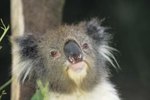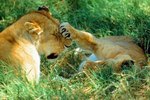
Koalas look like teddy bears, cute and cuddly. But they aren't bears. They are marsupials, whose defining trait is the females' stomach pouches, where their babies live for a few months after they're born. The koala's pouch is unusual: It opens backward, toward her hind legs, instead of forward, toward her head.
Pouch Direction
Most marsupials' pouches, such as the kangaroo's, face up. When the joey pops his head out, he's facing the same direction as his mom. Some marsupials, though, have backward-facing pouches to keep their young safe. Wombats, for example, have strong forearms used to dig burrows. Backward-flying dirt could quickly fill up a forward-facing pouch, so wombats' pouches face their hind legs. Closely related to wombats, koalas aren't diggers. They spend most of their time in trees, making it seem hazardous that their pouches open down instead of up.
Special Muscle
Koalas compensate for their upside-down pouches by using a special sphincter muscle along the outer edge of the pouch opening. A mother koala uses this muscle almost like a drawstring, closing the opening tightly as she climbs through the trees. Other marsupials have similar muscles, though they aren't designed to hold the baby in. Instead, they help the mom close her pouch when the outside temperature is cold so the babies stay warm.
Holding On
A baby koala does his share of the work to stay inside his mom's pouch. As a tiny newborn, about 3/4 inch long, he crawls from the birth canal into the pouch using his already strong forearms. He grips her fur inside the pouch to hang on tightly as needed. He makes his way over to one of her two teats, which swells up immediately as soon as his mouth closes on it. This helps him hang on with his mouth as well as his hands until he's big enough to explore outside the pouch.
Letting Go
Koala babies tend to remain completely inside the pouches until they're about 22 weeks old. Until then, their eyes are closed and they are still developing their fur. When their eyes open, they start poking their heads out of the pouches to look around. By age 30 weeks, a koala baby goes back into the pouch only to sleep and eat, enjoying time clinging to his mom's belly or back as she teaches him about life in the trees. At 36 weeks of age, most koala babies are learning to eat on their own and don't climb back into the pouch, although they still nurse. They stay with their moms until they're about 12 months old.
References
Photo Credits
-
Jupiterimages/Photos.com/Getty Images




